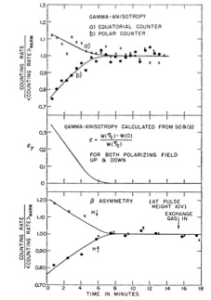In the 1950’s the decay of pions could not be explained by existing theories that assumed parity was conserved. Parity is the symmetry when one coordinate axis is replaced by its negative as happens when you look into a mirror. This transformation is the same as changing clockwise to counter clockwise, or right to left hands and it was assumed that such a transformation would leave physics unchanged. Two physicist Lee and Yang did a literature review and found that why there was experimental evidence that while parity was a symmetry in strong and electro-magntic interaction, there was no conclusive evidence that it was a symmetry in weak interactions. This led Chien-Shiung Wu to come up with an experiment to test for parity violation in beta decay. The experiment consisted of aligning radioactive Cobalt-60 in a magnetic field and cooling it to low temperature so it would stay aligned. The Cobalt-60 would decay to Iron-60 also emitting an electron and electron antineutrino and two photons. The photons are emitted by electro-magntic processes and therefore should be isotropic (just as likely to be in any direction). Detecting the electron and comparing its angular distribution to the gamma-rays would thus test the parity symmetry of the weak force. The experiment thus detected gamma-rays and electrons in two opposite directions and compared their frequency. The surprising result was that the electrons were detected to have a strong asymmetry meaning that parity was not a symmetry of the weak force. Lee and Yang won the Noble prize for this discovery in 1957, though Wu was not included as a recipient.
Data beta_polar, beta_equator, gamma_polar, gamma_equator.



